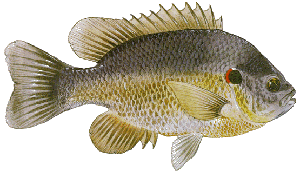Redear Sunfish (Lepomis microlophus)
- Other Names
- Shellcracker, Georgia Bream, Cherry Gill, Sunny, Sun Perch
- Description
- Lepomis, the generic name, is Greek and means "scaled gill cover." The species epithet microlophus is Greek for "small nape." The redear is a deep-bodied sunfish with a relatively small mouth. Color ranges from dark olive green above to almost white on the belly. The sides are usually yellow to green. The spinous dorsal fin, which is anterior to the soft dorsal fin, is normally equipped with 10 spines, although 9 or 11 spines are sometimes observed, and it is broadly connected to the soft dorsal fin. The anal fin has three spines. The species' most distinct characteristic is the red edge on the opercle ("ear") flap of the male (orange on the female). The opercle flap is never greatly elongated as it is in species such as the redbreast sunfish (Lepomis auritus) or the longear sunfish (L. megalotis).
- Life History
- Redear sunfish often utilize snails as a major food item, hence the common name "shellcracker." However, insect larvae and cladocerans may also be found in their diet. The species is usually found near the bottom in warm water with little current and abundant aquatic vegetation. Redears normally reach sexual maturity by the end of their second year. They spawn during the warm months of late spring and early summer, and in deeper water than most other sunfish, congregating in spawning "beds." Nests are saucer-shaped depressions in gravel or silt, and are sometimes so close they almost touch. There are usually one or two peaks of activity during spawning season. Few individuals survive more than six summers.
- Distribution
- Redear sunfish were originally found in the southeastern US from Texas north to a line even with southern Illinois and east to the Atlantic Ocean. As a result of introductions, the range has been expanded and now extends west into New Mexico and north into Michigan, Ohio and Pennsylvania. In Texas the species is native to the eastern two-thirds of the state from the Red River to the Rio Grande. It has been widely introduced throughout the state.
- Other
- Unlike some other sunfish species, redears rarely approach the surface to take flies or other artificial top baits. They may, however, be readily captured using natural bait such as earthworms and grubs. Redear are often taken in early summer when they are concentrated on spawning beds.
